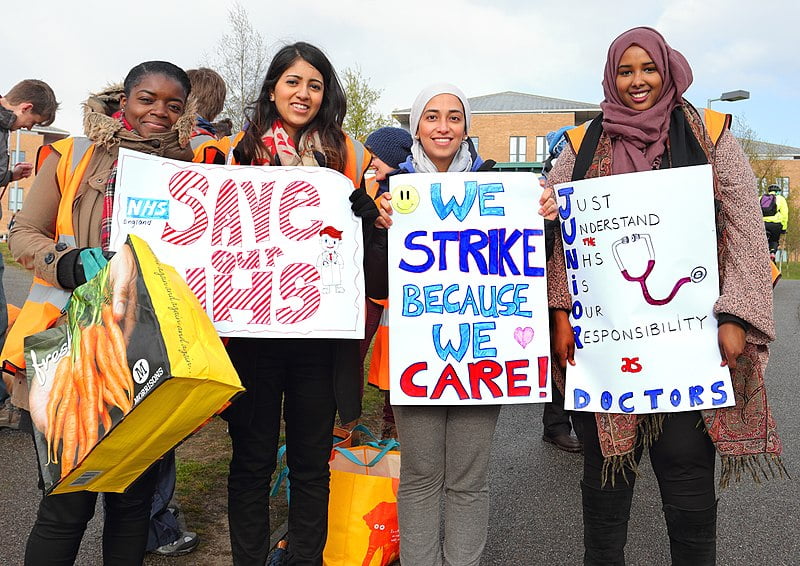Another week goes by. Hundreds of thousands of workers, mainly public sector, on strike last week, and again this week. Pay deals way below inflation. Zero movement from government. Continuing disruption and decay. Why can’t a settlement be reached?
Just before Christmas, Prime Minister Sunak told us
“I want to make sure that we reduce inflation and part of that is being responsible in setting public sector pay..”
On 1st February, Mr Sunak’s Official Spokesman said
“We want to have further talks with the unions. Some of these discussions have been constructive. We have to balance that against the need to be fair to all taxpayers, the majority of whom don’t work for the public sector.”
So two distinct arguments from government – to settle the current year public sector pay disputes would (1) be bad for inflation, and (2) unfair to taxpayers. Both are wrong.
Back in December, Mr Sunak claimed (quite wrongly) that it would cost some £28 billion pounds to pay an inflation-proofed pay rise.
A quick check on the figures, however, tells us that settling the pay disputes (for 2022/23) at a reasonable level would have no discernible impact on inflation, little or no impact on taxpayers – and on the contrary, would tend to boost the economy. It would, above all, start to restore some stability to our public services, whose rapid decay is so visible to all.
So let’s look at the big picture numbers involved. We can’t be precise about the exact additional expenditure required, but we can estimate the likely level with a strong degree of confidence. For a useful background of the issues, see this House of Commons research paper on Public Sector Pay (October 2022).
The scale of the pay problem
First, the scale of the pay problem. In brief, CPI inflation is running on average over the current year at almost exactly 10%. Average total weekly regular pay (according to ONS) has risen over the last year by 6.7% (November 2022 – the latest ONS data month – compared to November 2021).
Within this, average private sector pay has risen by 7.2%, but public sector pay by 3.9%. For most health service and central government workers, the current rise is less than that. So while most workers across all sectors are seeing their real pay and living standards fall, the position is far worse for most public sector workers, whose average real pay is presently down some 6 to 7% in a single year.
The size of the public workforce
Second, the numbers of staff to whom a settlement might apply. According to the Office for National Statistics (ONS), there are 3.6 million workers employed within what it calls central government, which includes NHS employees.
There are also 2 million local government employees, but many of these already have their pay settlement for the current financial year, which according to the trade union UNISON “averages out to around 7%”, with over 10% rise for the lowest paid.
Finally, there are around 180,000 employed in ‘public corporations’ which, since 2020, includes most rail employees whose Train Operation Companies are now in effect nationalized.
And just for comparison, over 27 million are employed in the private sector.
Many of the 3.6 million central government workers are part-time, however, so it is simpler to calculate full-time equivalents – which comes to 3.1 million FTEs. On top of this, I have added a further 500,000 FTEs to take account of those employed in education but treated as ‘local government’. Schools employment is split roughly equally between local government and, (for academies, central government (academies employ currently around 450,000 FTE), and the teaching staff pay award for this year is still in dispute. The total schools workforce is just under one million. There are also 62,000 FTE railway employees to take into account, so I have taken a broad total of 3.2 million FTEs for this calculation.
Average public sector pay
Average annual nominal pay for the public sector is today around £31,500 (based on ONS November 2022 statistics, which show average weekly public sector pay at £605, which includes the local government pay rise). For the 3.2 million FTE staff we are considering, that makes a wage bill of £101 billion. On top of wage/salary, there are employer contributions including employer national insurance, and employer pension contributions. Let’s estimate 25% for these, making the total FTE employment unit cost of around £39,500. Multiplying this by 3.2 million FTEs, we get a total employment cost of £126 billion. Of this sum, the employer’s national insurance contribution comes straight back to the Treasury, so the overall total employer cost is closer to £118 billion.
For comparison, the total public sector employment cost (including NI) was around £233 billion in 2021-22, including the whole local government sector and all public corporations.
What level of additional pay settlement, and how much will it cost?
The purpose of this article is not to lay down what should be the pay settlement for all or any specific group of staff (anything less than the rate of inflation is in essence a real pay reduction), but to estimate what cost it is reasonable to assume in order to resolve current pay disputes, including knock-on effects.
Given that public sector pay has so far risen overall in most areas by 3 to 4% in the current year, it seems reasonable to set our estimate of ‘the cost of settlement of public sector disputes’ on a further increase this financial year, on average, of 5% to 6%. That would make an average pay rise for the current financial year of around 8-10%. Here, we examine the financial and economic impact of an average 5% additional settlement, i.e. a total of around 8 to 9%. That still implies a small but notable real pay reduction, but we think is a realistic scenario for ending disputes.
For a total annual current employer-cost of £118 billion (net of employer NI contribution), this comes to an additional £5.9 billion.
But of this £5.9 billion, some £5 billion represents the 5% increase on the salary cost of £101 billion. We need to deduct income tax and employee national insurance from this pure pay element, which come to around 20% of the total salary, and are immediately paid back to the government. 20% of £5 billion is £1 billion, leaving the total extra bill of around £4.9 billion.
We need to recognize that around 25% of the overall increase will be saved via the combined employer and employee pension contributions; these pension savings will be invested in a combination of assets, with a substantial proportion in gilts (government bonds).
After taking account of these pension deductions, the increased net employee income amounts to around £3.7 billion. The additional employer contribution remains a cost to government.
Next, we need to estimate how much of this pay rise of £3.7 billion, net of pension contributions, will be paid to government over the course of the following months in other taxes and charges, in particular VAT.
This depends on how much of the increase is spent, and how much ‘saved’, but generally, we may assume that – since most public sector employees are on fairly modest incomes (and are already saving via their pension scheme) – most or all of our estimated pay increase of £3.7 billion will indeed be spent by the employees, and a significant sum will be paid in VAT etc.. This therefore brings the total direct cost to government (which we estimate above at £4.9 billion) down further, to around £4.6 billion.
To put £4.6 billion in perspective, the UK’s annual current GDP is in the region of £2.5 trillion. One per cent of GDP is around £25 billion, so the net cost to government of the pay dispute, on our above estimated basis, is a little under 0.2% of GDP. While not negligible, it is in reality a minute proportion of our overall economy. But it does not end there.
The multiplier effect
When we spend into the local UK economy, we pay the incomes of other UK businesses and citizens, less the amount that goes to other countries via the cost of imports. If most of the net employee income of £3.7 billion is spent, we may assume that this boosts UK production by a slightly smaller amount, say £3 – 3.5 billion. Of this ‘income of other citizens and businesses’, those citizens and businesses in turn pay taxes on their incomes and profits, all of which increase as a result of this additional spending. The government gets back more. If we assume 25% is in due course paid to government as taxes (direct and indirect) due to such spending, this takes a further £800 million off the total cost to government, bringing it to £3.8 billion. And so on down the chain. This is the magic of the multiplier, consistently underestimated by the Treasury and Office for Budgetary Responsibility.
The impact on inflation
The current inflation is caused, in the view of most economists, by external forces, shocks and shortages (post-pandemic shortages, effects of war), not to internal UK excesses of aggregate demand, and certainly not due to excessive wage rises. This causation is recognized in the latest (February) Monetary Policy Report of the Bank of England (BoE).
On demand, we can estimate, from ONS’s data for Q3 GDP, that for the full year 2022 household consumption, in volume terms, is likely to be around 5% higher than in 2021, but 2% less than in 2019. (Q1 in 2021 was particularly low, with lockdown in place for some time, otherwise the difference would be much less).
In nominal terms, household consumption in 2022 is likely to be 16% greater than in 2021, due largely to the increases in energy and fuel costs, but only 8% higher than in 2019. For comparison, over the period December 2019 to December 2022, CPI inflation has risen by 17%.
On wages, as we have seen, increases have remained well below the rate of inflation, with ONS’s real wage tables showing a fall in total and regular pay of 2.4% compared to 2021. (Compared to November 2019, total real pay in November 2022 was 1.2% higher, while real regular pay – excluding bonuses and one-offs – was at precisely the same level as 2019).
While the BoE claims still to worry that increased wage settlements may be an ‘upside risk’ for inflation, this can hardly be the case for at-or-below-inflation pay rises for public sector workers, given that their pay is not connected to market price-setting in the same way as private sector pay may arguably be.
The net cost – who pays?
There is only an additional direct net cost to government if an increase in pay is funded by it – which means a late addition to departmental cash limits. Otherwise, an unfunded pay rise leads to a reduced workforce (via redundancies) or damaging reductions in non-staffing costs. So, a fair pay rise for public sector workers in the current financial year needs to be funded, which broadly would add £5 billion to this year’s public sector cost. To put this in context, the total current government budget expenditure for this year is a little over £1,062 billion, so an initial increase of £5 billion represents an increase of just under 1/212th or just under 0.5%.
Also for comparison, the cost of the energy support package was estimated at £43 billion, while total public sector net borrowing for the current year is estimated at £177 billion.
If communicated in a sensible and reasoned way (despite the government’s record on the issue), there is next to zero risk of generating negative reaction from the gilt markets for this small variation.
If funded from new tax income (to the extent it does not generate additional tax income), the £5 billion increase represents almost exactly 0.5% of estimated public sector receipts (from taxes and other sources). A higher VAT level on luxury goods would be an option to consider – a purchase tax of 33% was introduced in World War 2 on such goods.
The cost of not increasing pay this year
As we have seen, public sector workers are striking for more pay in numbers not seen for a generation. Throughout this week, hundreds of thousands of NHS employees will take action. Economic life has been disrupted for months by railway workers’ action. Teachers are likewise taking strike action in growing numbers.
Over the present age of austerity, we see everywhere signs of a general decay in the scope, availability and quality of our public services, on which most citizens depend or will depend. For a greener, more resilient future, we increasingly will need to depend on good quality public services. They are not a net cost but a net benefit. They are essential to a decent society, and an investment in today’s and our future economy.
There is also a more short-term benefit in settling this year’s pay now at a fair level. As well as bringing back some much-needed stability and reliability to our public services, it will reduce the pressure for a higher catch-up pay deal for 2023-24, when the annual rate of inflation should be reducing as the shock factors that caused the leap in inflation subside. It will thus help to smooth the year-on-year evolution of government finances, and promote a sensible policy on public services and their role in the economy and wider society.




